Python 中图像标题生成的注意力机制实战
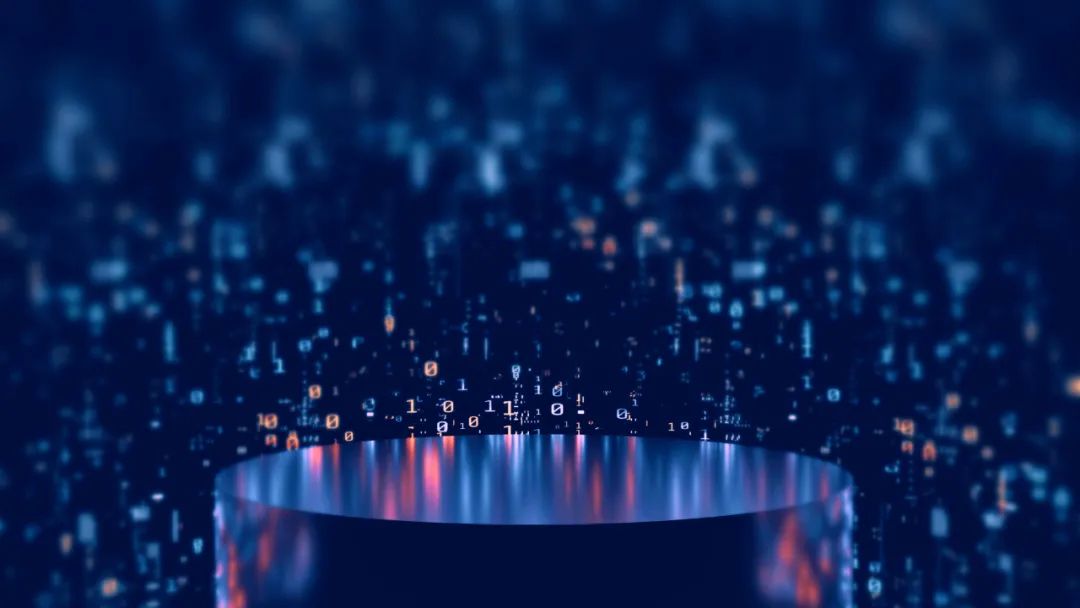
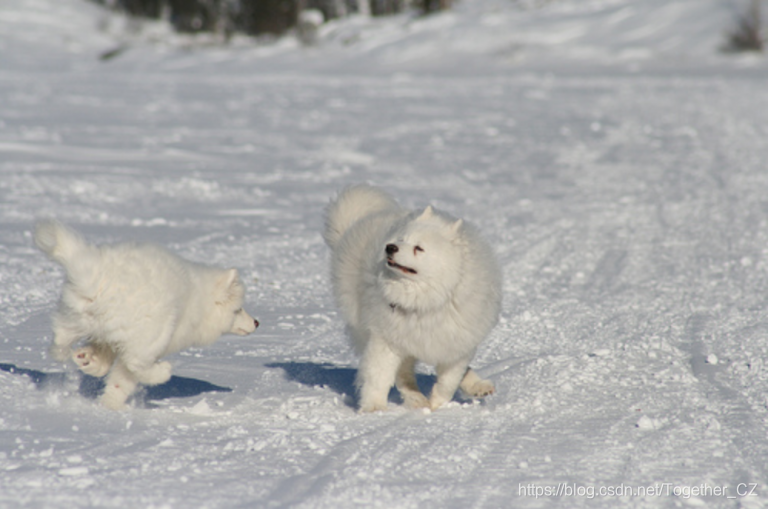
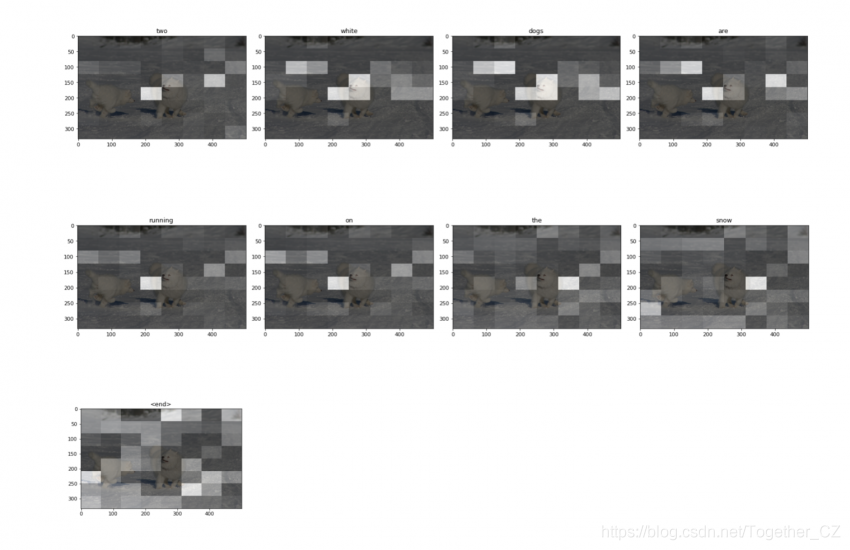
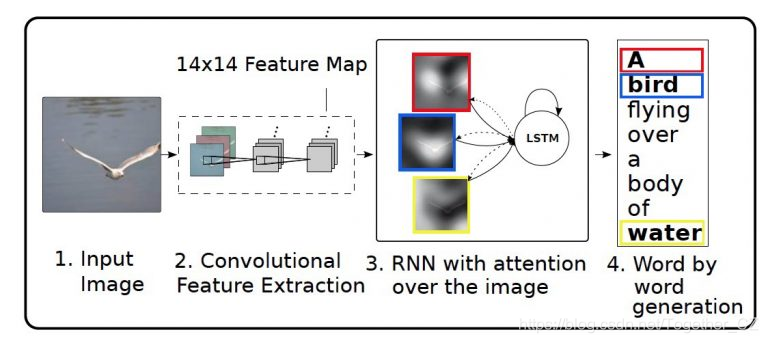

import string
import numpy as np
import pandas as pd
from numpy import array
from pickle import load
from PIL import Image
import pickle
from collections import Counter
import matplotlib.pyplot as plt
import sys, time, os, warnings
warnings.filterwarnings("ignore")
import re
import keras
import tensorflow as tf
from tqdm import tqdm
from nltk.translate.bleu_score import sentence_bleu
from keras.preprocessing.sequence import pad_sequences
from keras.utils import to_categorical
from keras.utils import plot_model
from keras.models import Model
from keras.layers import Input
from keras.layers import Dense, BatchNormalization
from keras.layers import LSTM
from keras.layers import Embedding
from keras.layers import Dropout
from keras.layers.merge import add
from keras.callbacks import ModelCheckpoint
from keras.preprocessing.image import load_img, img_to_array
from keras.preprocessing.text import Tokenizer
from keras.applications.vgg16 import VGG16, preprocess_input
from sklearn.utils import shuffle
from sklearn.model_selection import train_test_split
from sklearn.utils import shuffle
image_path = "/content/gdrive/My Drive/FLICKR8K/Flicker8k_Dataset"
dir_Flickr_text = "/content/gdrive/My Drive/FLICKR8K/Flickr8k_text/Flickr8k.token.txt"
jpgs = os.listdir(image_path)
print("Total Images in Dataset = {}".format(len(jpgs)))

file = open(dir_Flickr_text,'r')
text = file.read()
file.close()
datatxt = []
for line in text.split('\n'):
col = line.split('\t')
if len(col) == 1:
continue
w = col[0].split("#")
datatxt.append(w + [col[1].lower()])
data = pd.DataFrame(datatxt,columns=["filename","index","caption"])
data = data.reindex(columns =['index','filename','caption'])
data = data[data.filename != '2258277193_586949ec62.jpg.1']
uni_filenames = np.unique(data.filename.values)
data.head()

npic = 5
npix = 224
target_size = (npix,npix,3)
count = 1
fig = plt.figure(figsize=(10,20))
for jpgfnm in uni_filenames[10:14]:
filename = image_path + '/' + jpgfnm
captions = list(data["caption"].loc[data["filename"]==jpgfnm].values)
image_load = load_img(filename, target_size=target_size)
ax = fig.add_subplot(npic,2,count,xticks=[],yticks=[])
ax.imshow(image_load)
count += 1
ax = fig.add_subplot(npic,2,count)
plt.axis('off')
ax.plot()
ax.set_xlim(0,1)
ax.set_ylim(0,len(captions))
for i, caption in enumerate(captions):
ax.text(0,i,caption,fontsize=20)
count += 1
plt.show()
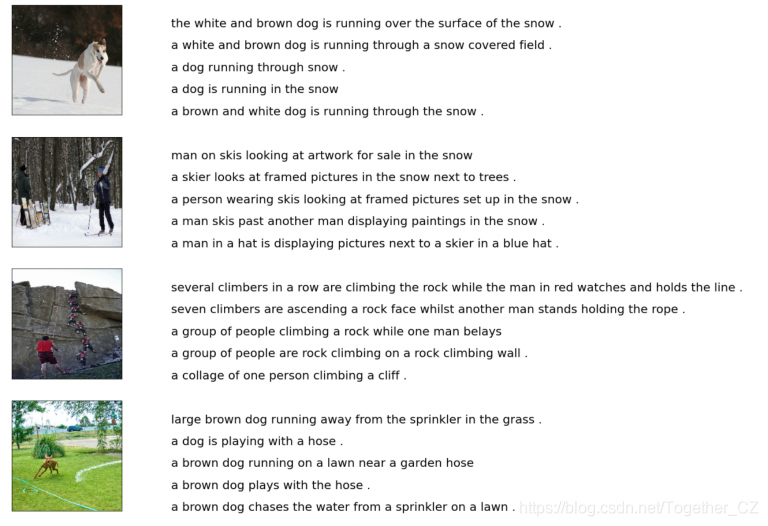
vocabulary = []
for txt in data.caption.values:
vocabulary.extend(txt.split())
print('Vocabulary Size: %d' % len(set(vocabulary)))

def remove_punctuation(text_original):
text_no_punctuation = text_original.translate(string.punctuation)
return(text_no_punctuation)
def remove_single_character(text):
text_len_more_than1 = ""
for word in text.split():
if len(word) > 1:
text_len_more_than1 += " " + word
return(text_len_more_than1)
def remove_numeric(text):
text_no_numeric = ""
for word in text.split():
isalpha = word.isalpha()
if isalpha:
text_no_numeric += " " + word
return(text_no_numeric)
def text_clean(text_original):
text = remove_punctuation(text_original)
text = remove_single_character(text)
text = remove_numeric(text)
return(text)
for i, caption in enumerate(data.caption.values):
newcaption = text_clean(caption)
data["caption"].iloc[i] = newcaption
clean_vocabulary = []
for txt in data.caption.values:
clean_vocabulary.extend(txt.split())
print('Clean Vocabulary Size: %d' % len(set(clean_vocabulary)))

PATH = "/content/gdrive/My Drive/FLICKR8K/Flicker8k_Dataset/"
all_captions = []
for caption in data["caption"].astype(str):
caption = '<start> ' + caption+ ' <end>'
all_captions.append(caption)
all_captions[:10]

all_img_name_vector = []
for annot in data["filename"]:
full_image_path = PATH + annot
all_img_name_vector.append(full_image_path)
all_img_name_vector[:10]

print(f"len(all_img_name_vector) : {len(all_img_name_vector)}")
print(f"len(all_captions) : {len(all_captions)}")

def data_limiter(num,total_captions,all_img_name_vector):
train_captions, img_name_vector = shuffle(total_captions,all_img_name_vector,random_state=1)
train_captions = train_captions[:num]
img_name_vector = img_name_vector[:num]
return train_captions,img_name_vector
train_captions,img_name_vector = data_limiter(40000,total_captions,all_img_name_vector)
def load_image(image_path):
img = tf.io.read_file(image_path)
img = tf.image.decode_jpeg(img, channels=3)
img = tf.image.resize(img, (224, 224))
img = preprocess_input(img)
return img, image_path
image_model = tf.keras.applications.VGG16(include_top=False, weights='imagenet')
new_input = image_model.input
hidden_layer = image_model.layers[-1].output
image_features_extract_model = tf.keras.Model(new_input, hidden_layer)
image_features_extract_model.summary()

encode_train = sorted(set(img_name_vector))
image_dataset = tf.data.Dataset.from_tensor_slices(encode_train)
image_dataset = image_dataset.map(load_image, num_parallel_calls=tf.data.experimental.AUTOTUNE).batch(64)
%%time
for img, path in tqdm(image_dataset):
batch_features = image_features_extract_model(img)
batch_features = tf.reshape(batch_features,
(batch_features.shape[0], -1, batch_features.shape[3]))
for bf, p in zip(batch_features, path):
path_of_feature = p.numpy().decode("utf-8")
np.save(path_of_feature, bf.numpy())
top_k = 5000
tokenizer = tf.keras.preprocessing.text.Tokenizer(num_words=top_k,
oov_token="<unk>",
filters='!"#$%&()*+.,-/:;=?@[\]^_`{|}~ ')
tokenizer.fit_on_texts(train_captions)
train_seqs = tokenizer.texts_to_sequences(train_captions)
tokenizer.word_index['<pad>'] = 0
tokenizer.index_word[0] = '<pad>'
train_seqs = tokenizer.texts_to_sequences(train_captions)
cap_vector = tf.keras.preprocessing.sequence.pad_sequences(train_seqs, padding='post')
train_captions[:3]

train_seqs[:3]

def calc_max_length(tensor):
return max(len(t) for t in tensor)
max_length = calc_max_length(train_seqs)
def calc_min_length(tensor):
return min(len(t) for t in tensor)
min_length = calc_min_length(train_seqs)
print('Max Length of any caption : Min Length of any caption = '+ str(max_length) +" : "+str(min_length))

img_name_train, img_name_val, cap_train, cap_val = train_test_split(img_name_vector,cap_vector, test_size=0.2, random_state=0)
BATCH_SIZE = 64
BUFFER_SIZE = 1000
embedding_dim = 256
units = 512
vocab_size = len(tokenizer.word_index) + 1
num_steps = len(img_name_train) // BATCH_SIZE
features_shape = 512
attention_features_shape = 49
def map_func(img_name, cap):
img_tensor = np.load(img_name.decode('utf-8')+'.npy')
return img_tensor, cap
dataset = tf.data.Dataset.from_tensor_slices((img_name_train, cap_train))
# Use map to load the numpy files in parallel
dataset = dataset.map(lambda item1, item2: tf.numpy_function(
map_func, [item1, item2], [tf.float32, tf.int32]),
num_parallel_calls=tf.data.experimental.AUTOTUNE)
dataset = dataset.shuffle(BUFFER_SIZE).batch(BATCH_SIZE)
dataset = dataset.prefetch(buffer_size=tf.data.experimental.AUTOTUNE)
class VGG16_Encoder(tf.keras.Model):
# This encoder passes the features through a Fully connected layer
def __init__(self, embedding_dim):
super(VGG16_Encoder, self).__init__()
# shape after fc == (batch_size, 49, embedding_dim)
self.fc = tf.keras.layers.Dense(embedding_dim)
self.dropout = tf.keras.layers.Dropout(0.5, noise_shape=None, seed=None)
def call(self, x):
#x= self.dropout(x)
x = self.fc(x)
x = tf.nn.relu(x)
return x
def rnn_type(units):
if tf.test.is_gpu_available():
return tf.compat.v1.keras.layers.CuDNNLSTM(units,
return_sequences=True,
return_state=True,
recurrent_initializer='glorot_uniform')
else:
return tf.keras.layers.GRU(units,
return_sequences=True,
return_state=True,
recurrent_activation='sigmoid',
recurrent_initializer='glorot_uniform')
接下来,使用Bahdanau注意定义RNN解码器:
'''The encoder output(i.e. 'features'), hidden state(initialized to 0)(i.e. 'hidden') and
the decoder input (which is the start token)(i.e. 'x') is passed to the decoder.'''
class Rnn_Local_Decoder(tf.keras.Model):
def __init__(self, embedding_dim, units, vocab_size):
super(Rnn_Local_Decoder, self).__init__()
self.units = units
self.embedding = tf.keras.layers.Embedding(vocab_size, embedding_dim)
self.gru = tf.keras.layers.GRU(self.units,
return_sequences=True,
return_state=True,
recurrent_initializer='glorot_uniform')
self.fc1 = tf.keras.layers.Dense(self.units)
self.dropout = tf.keras.layers.Dropout(0.5, noise_shape=None, seed=None)
self.batchnormalization = tf.keras.layers.BatchNormalization(axis=-1, momentum=0.99, epsilon=0.001, center=True, scale=True, beta_initializer='zeros', gamma_initializer='ones', moving_mean_initializer='zeros', moving_variance_initializer='ones', beta_regularizer=None, gamma_regularizer=None, beta_constraint=None, gamma_constraint=None)
self.fc2 = tf.keras.layers.Dense(vocab_size)
# Implementing Attention Mechanism
self.Uattn = tf.keras.layers.Dense(units)
self.Wattn = tf.keras.layers.Dense(units)
self.Vattn = tf.keras.layers.Dense(1)
def call(self, x, features, hidden):
# features shape ==> (64,49,256) ==> Output from ENCODER
# hidden shape == (batch_size, hidden_size) ==>(64,512)
# hidden_with_time_axis shape == (batch_size, 1, hidden_size) ==> (64,1,512)
hidden_with_time_axis = tf.expand_dims(hidden, 1)
# score shape == (64, 49, 1)
# Attention Function
'''e(ij) = f(s(t-1),h(j))'''
''' e(ij) = Vattn(T)*tanh(Uattn * h(j) + Wattn * s(t))'''
score = self.Vattn(tf.nn.tanh(self.Uattn(features) + self.Wattn(hidden_with_time_axis)))
# self.Uattn(features) : (64,49,512)
# self.Wattn(hidden_with_time_axis) : (64,1,512)
# tf.nn.tanh(self.Uattn(features) + self.Wattn(hidden_with_time_axis)) : (64,49,512)
# self.Vattn(tf.nn.tanh(self.Uattn(features) + self.Wattn(hidden_with_time_axis))) : (64,49,1) ==> score
# you get 1 at the last axis because you are applying score to self.Vattn
# Then find Probability using Softmax
'''attention_weights(alpha(ij)) = softmax(e(ij))'''
attention_weights = tf.nn.softmax(score, axis=1)
# attention_weights shape == (64, 49, 1)
# Give weights to the different pixels in the image
''' C(t) = Summation(j=1 to T) (attention_weights * VGG-16 features) '''
context_vector = attention_weights * features
context_vector = tf.reduce_sum(context_vector, axis=1)
# Context Vector(64,256) = AttentionWeights(64,49,1) * features(64,49,256)
# context_vector shape after sum == (64, 256)
# x shape after passing through embedding == (64, 1, 256)
x = self.embedding(x)
# x shape after concatenation == (64, 1, 512)
x = tf.concat([tf.expand_dims(context_vector, 1), x], axis=-1)
# passing the concatenated vector to the GRU
output, state = self.gru(x)
# shape == (batch_size, max_length, hidden_size)
x = self.fc1(output)
# x shape == (batch_size * max_length, hidden_size)
x = tf.reshape(x, (-1, x.shape[2]))
# Adding Dropout and BatchNorm Layers
x= self.dropout(x)
x= self.batchnormalization(x)
# output shape == (64 * 512)
x = self.fc2(x)
# shape : (64 * 8329(vocab))
return x, state, attention_weights
def reset_state(self, batch_size):
return tf.zeros((batch_size, self.units))
encoder = VGG16_Encoder(embedding_dim)
decoder = Rnn_Local_Decoder(embedding_dim, units, vocab_size)
optimizer = tf.keras.optimizers.Adam()
loss_object = tf.keras.losses.SparseCategoricalCrossentropy(
from_logits=True, reduction='none')
def loss_function(real, pred):
mask = tf.math.logical_not(tf.math.equal(real, 0))
loss_ = loss_object(real, pred)
mask = tf.cast(mask, dtype=loss_.dtype)
loss_ *= mask
return tf.reduce_mean(loss_)
loss_plot = []
@tf.function
def train_step(img_tensor, target):
loss = 0
# initializing the hidden state for each batch
# because the captions are not related from image to image
hidden = decoder.reset_state(batch_size=target.shape[0])
dec_input = tf.expand_dims([tokenizer.word_index['<start>']] * BATCH_SIZE, 1)
with tf.GradientTape() as tape:
features = encoder(img_tensor)
for i in range(1, target.shape[1]):
# passing the features through the decoder
predictions, hidden, _ = decoder(dec_input, features, hidden)
loss += loss_function(target[:, i], predictions)
# using teacher forcing
dec_input = tf.expand_dims(target[:, i], 1)
total_loss = (loss / int(target.shape[1]))
trainable_variables = encoder.trainable_variables + decoder.trainable_variables
gradients = tape.gradient(loss, trainable_variables)
optimizer.apply_gradients(zip(gradients, trainable_variables))
return loss, total_loss
EPOCHS = 20
for epoch in range(start_epoch, EPOCHS):
start = time.time()
total_loss = 0
for (batch, (img_tensor, target)) in enumerate(dataset):
batch_loss, t_loss = train_step(img_tensor, target)
total_loss += t_loss
if batch % 100 == 0:
print ('Epoch {} Batch {} Loss {:.4f}'.format(
epoch + 1, batch, batch_loss.numpy() / int(target.shape[1])))
# storing the epoch end loss value to plot later
loss_plot.append(total_loss / num_steps)
print ('Epoch {} Loss {:.6f}'.format(epoch + 1,
total_loss/num_steps))
print ('Time taken for 1 epoch {} sec\n'.format(time.time() - start))
plt.plot(loss_plot)
plt.xlabel('Epochs')
plt.ylabel('Loss')
plt.title('Loss Plot')
plt.show()
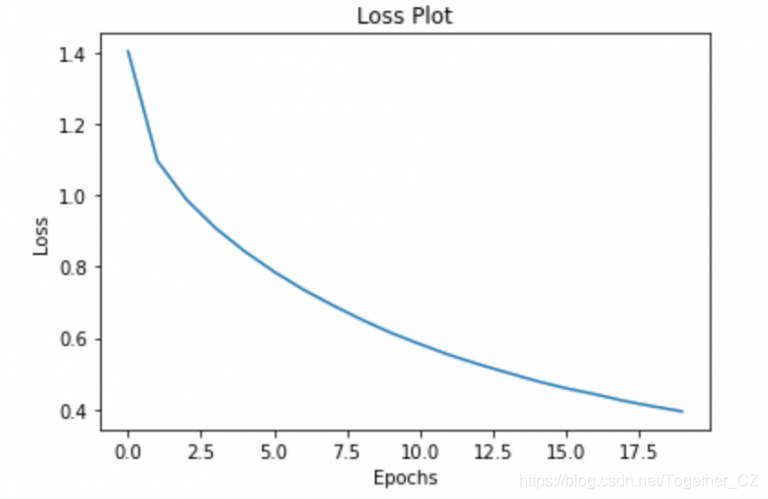
def evaluate(image):
attention_plot = np.zeros((max_length, attention_features_shape))
hidden = decoder.reset_state(batch_size=1)
temp_input = tf.expand_dims(load_image(image)[0], 0)
img_tensor_val = image_features_extract_model(temp_input)
img_tensor_val = tf.reshape(img_tensor_val, (img_tensor_val.shape[0], -1, img_tensor_val.shape[3])
features = encoder(img_tensor_val)
dec_input = tf.expand_dims([tokenizer.word_index['<start>']], 0)
result = []
for i in range(max_length):
predictions, hidden, attention_weights = decoder(dec_input, features, hidden)
attention_plot[i] = tf.reshape(attention_weights, (-1, )).numpy()
predicted_id = tf.argmax(predictions[0]).numpy()
result.append(tokenizer.index_word[predicted_id])
if tokenizer.index_word[predicted_id] == '<end>':
return result, attention_plot
dec_input = tf.expand_dims([predicted_id], 0)
attention_plot = attention_plot[:len(result), :]
return result, attention_plot
def plot_attention(image, result, attention_plot):
temp_image = np.array(Image.open(image))
fig = plt.figure(figsize=(10, 10))
len_result = len(result)
for l in range(len_result):
temp_att = np.resize(attention_plot[l], (8, 8))
ax = fig.add_subplot(len_result//2, len_result//2, l+1)
ax.set_title(result[l])
img = ax.imshow(temp_image)
ax.imshow(temp_att, cmap='gray', alpha=0.6, extent=img.get_extent())
plt.tight_layout()
plt.show()
# captions on the validation set
rid = np.random.randint(0, len(img_name_val))
image = '/content/gdrive/My Drive/FLICKR8K/Flicker8k_Dataset/2319175397_3e586cfaf8.jpg'
# real_caption = ' '.join([tokenizer.index_word[i] for i in cap_val[rid] if i not in [0]])
result, attention_plot = evaluate(image)
# remove <start> and <end> from the real_caption
first = real_caption.split(' ', 1)[1]
real_caption = 'Two white dogs are playing in the snow'
#remove "<unk>" in result
for i in result:
if i=="<unk>":
result.remove(i)
for i in real_caption:
if i=="<unk>":
real_caption.remove(i)
#remove <end> from result
result_join = ' '.join(result)
result_final = result_join.rsplit(' ', 1)[0]
real_appn = []
real_appn.append(real_caption.split())
reference = real_appn
candidate = result
score = sentence_bleu(reference, candidate)
print(f"BELU score: {score*100}")
print ('Real Caption:', real_caption)
print ('Prediction Caption:', result_final)
plot_attention(image, result, attention_plot)
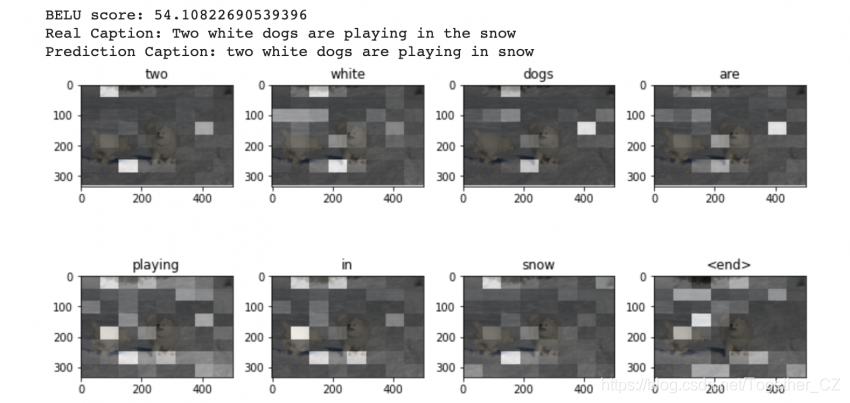
rid = np.random.randint(0, len(img_name_val))
image = img_name_val[rid]
start = time.time()
real_caption = ' '.join([tokenizer.index_word[i] for i in cap_val[rid] if i not in [0]])
result, attention_plot = evaluate(image)
first = real_caption.split(' ', 1)[1]
real_caption = first.rsplit(' ', 1)[0]
#remove "<unk>" in result
for i in result:
if i=="<unk>":
result.remove(i)
#remove <end> from result
result_join = ' '.join(result)
result_final = result_join.rsplit(' ', 1)[0]
real_appn = []
real_appn.append(real_caption.split())
reference = real_appn
candidate = result_final
print ('Real Caption:', real_caption)
print ('Prediction Caption:', result_final)
plot_attention(image, result, attention_plot)
print(f"time took to Predict: {round(time.time()-start)} sec")
Image.open(img_name_val[rid])
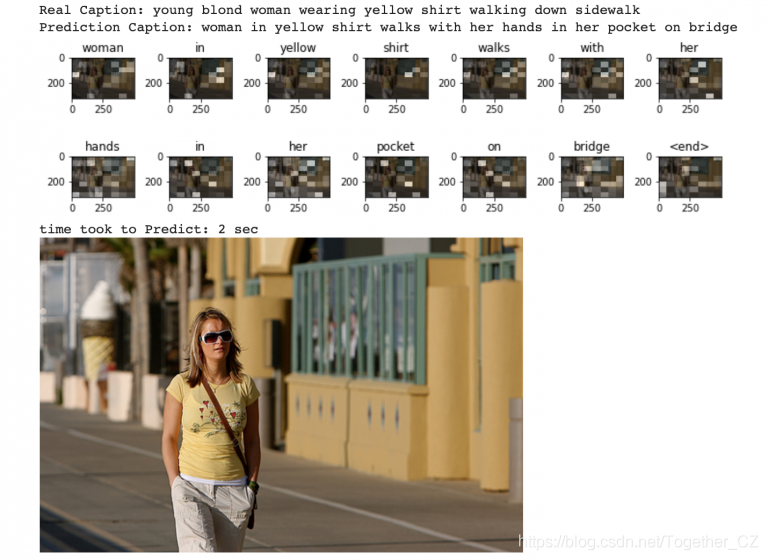
rid = np.random.randint(0, len(img_name_val))
image = img_name_val[rid]
real_caption = ' '.join([tokenizer.index_word[i] for i in cap_val[rid] if i not in [0]])
result, attention_plot = evaluate(image)
# remove <start> and <end> from the real_caption
first = real_caption.split(' ', 1)[1]
real_caption = first.rsplit(' ', 1)[0]
#remove "<unk>" in result
for i in result:
if i=="<unk>":
result.remove(i)
for i in real_caption:
if i=="<unk>":
real_caption.remove(i)
#remove <end> from result
result_join = ' '.join(result)
result_final = result_join.rsplit(' ', 1)[0]
real_appn = []
real_appn.append(real_caption.split())
reference = real_appn
candidate = result
score = sentence_bleu(reference, candidate)
print(f"BELU score: {score*100}")
print ('Real Caption:', real_caption)
print ('Prediction Caption:', result_final)
plot_attention(image, result, attention_plot)
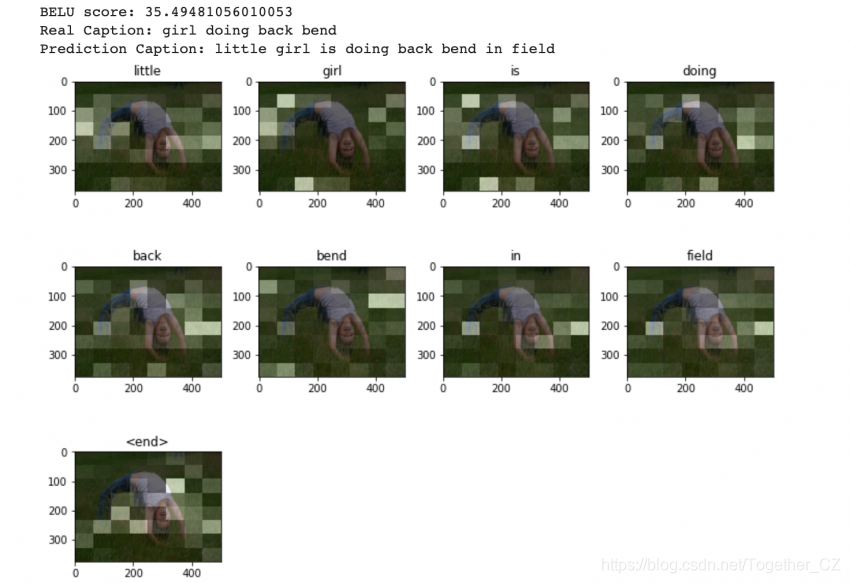
作者:沂水寒城,CSDN博客专家,个人研究方向:机器学习、深度学习、NLP、CV
Blog: http://yishuihancheng.blog.csdn.net
赞 赏 作 者
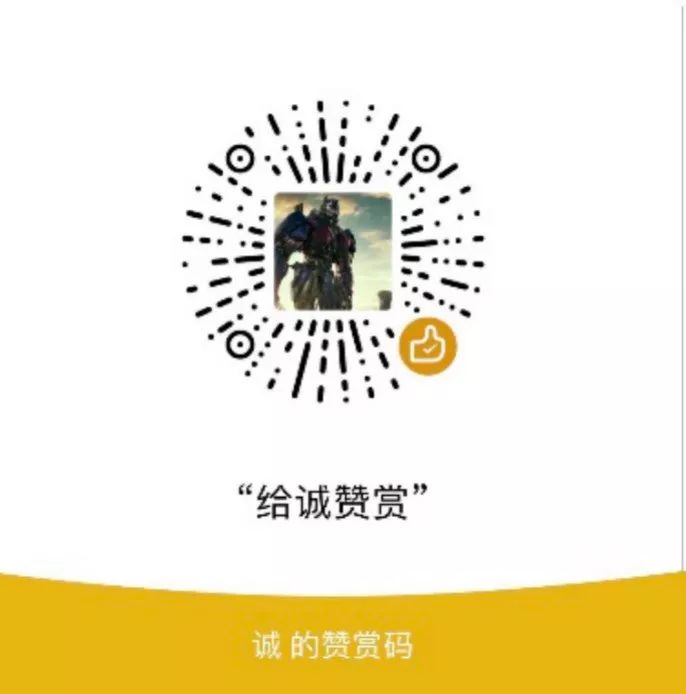
更多阅读
特别推荐
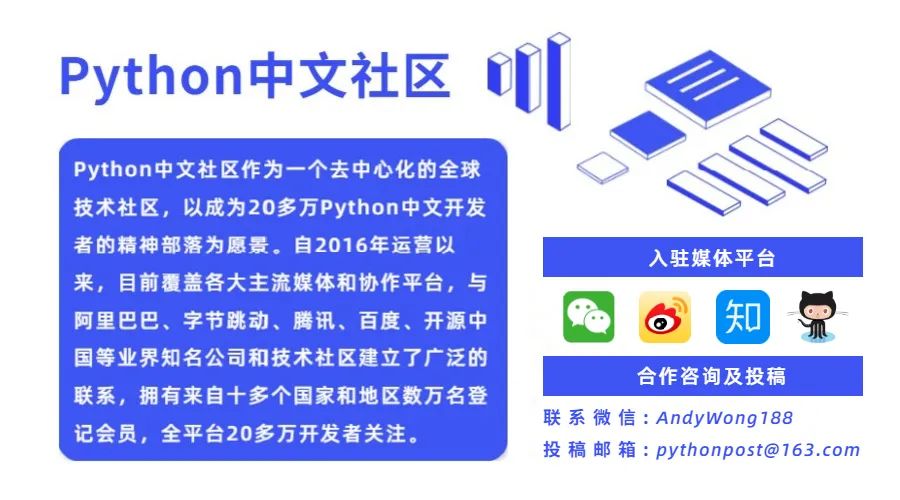
点击下方阅读原文加入社区会员
评论
